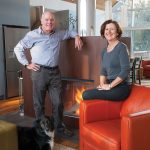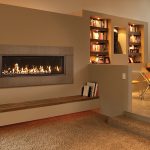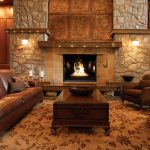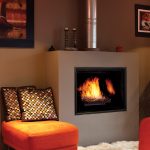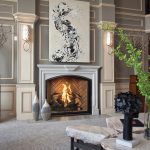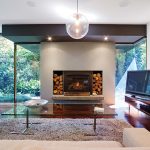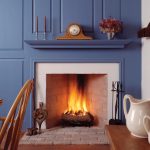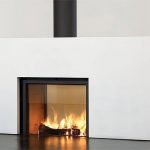Smart technology meets the modern fireplace.
by Judy Ross
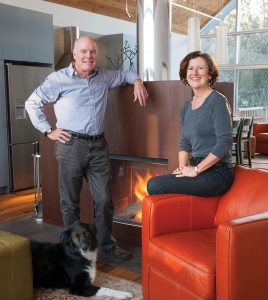
Just mention the word “fireplace” and thoughts of cosiness and warmth come to mind. As one of the home’s most desired assets, a fireplace brings both a sense of comfort and an appealing focal point to any room. For years the traditional facings have been stone and brick, especially in rustic country houses where weathered barn beams often served as mantelpieces. But today’s modern fireplaces are anything but traditional in looks or function. They come in stylish contemporary designs and, due to advanced technology, can be installed almost anywhere.
It just takes the flick of a switch for a fire to burst to life behind a wall of glass in any room of the house. The most stunning innovation is a ventless fireplace that is like a decorative piece of furniture. Made by HearthCabinet, these use a safe, clean-burning gel fuel cartridge system and don’t require any form of connection or venting. If you want to be able to warm your toes in front of a fireplace this winter, the options are endless and easily available.
CHOOSE YOUR FUEL
ELECRIC
Electric fireplaces are the least expensive and easiest to install. Some models sell at big box stores like Home Depot for as little as $200 and just need to be brought home and plugged in. In the past they looked fake – a poor attempt to replicate burning coal or logs – but newer models bear some resemblance to a smouldering fire. You can’t count on them for much heat unless you have a room that is smaller than 200 square feet, but they do take the chill off and provide a little ambience and glow during the dark nights of winter.
WOOD
Surprisingly, traditional wood-burning fireplaces don’t do much to heat your home, either. Although new technology has improved their efficiency, most of the heat escapes up the chimney. They are expensive to install because they require masonry and must be vented vertically through a chimney. In custom-built homes or additions, fireplaces are sketched into the blueprints, which often feature multiple fireplaces and chimneys. Deciding where and what kind of fireplace you want does require pre-planning. It’s difficult to install a masonry fireplace after the fact without tearing an existing house apart.
A wood-burning fireplace is more labour intensive. You need to buy or chop wood, lay the fire and tend the fire to make sure it doesn’t fizzle out. Then, you need to have the chimney cleaned annually and regularly sweep out the ash build-up, being careful not to let a live ember land on the carpet. But it’s all worth it for most advocates who can’t imagine curling up in front of any other kind of fire.
“Most of the weekenders want wood-burning fireplaces,” notes Anna Tomlinson, owner of Chantico Fireplace Gallery in Craigleith, a company that is responsible for many of the custom-built fireplaces in this area. “They feel it goes with the whole experience of living here. One of our clients, who also has a wood fireplace in the city home, says they burn more wood over one weekend here than the entire season at home.”
It’s true that in the depths of winter there’s nothing better than the comforting smell of wood smoke and the crackle and hiss of logs burning in a massive fireplace.
Rumford fireplaces are still the gold standard in wood-burning fireplace design. These grandly proportioned fireplaces were devised over 200 years ago by Count Rumford, an English/American inventor, and feature a large and high opening with a shallow, smooth brick interior designed to reflect heat back into the room. The slant and angles of the sides and back are what distinguish the design and keep the smoke from entering the room. They come with ‘guillotine’ doors and screens that slide upwards and disappear altogether for an open fire look and then can be closed for safety as the fire dies down. Fans of these classic fireplaces love their open, arched look and their ability to produce plenty of radiant heat, draw well and burn for hours.
GAS
For convenience, it’s hard to beat gas. The gas fireplace industry is about 35 years old and over those years the technology has changed dramatically. Early versions were unattractive with perforated steel tubes (like those beneath the coals in a gas barbecue) that looked industrial rather than charming. Today the stylish designs of gas fireplaces include linear glass boxes with ribbons of fire dancing among river rocks to ones that are more ‘fire feature’ than ‘fireplace.’
For instance, you can have a shooting flame burning behind vertical glass panels, a look that resembles torches at a medieval banquet. But still the most popular style in traditional settings is to replicate the look of a wood-burning hearth with charred embers and robust yellow flames. Some are so life-like it’s hard to tell if the wood is real or not.
Most manufacturers allow you to customize your own look by choosing from dozens of options.
“The sky’s the limit,” declares John Buhagiar, owner of Community Gas and Mechanical Services in Wasaga Beach. In his 26 years in business, the gas fireplace has come a long way. As he points out, you can choose the shape and size of the firebox, the style of burner, and the kind of facing that suits your home décor. And with programmable control panels you can now operate your fireplace from your smartphone.
The biggest technological advance has been power venting, a game changer in the gas fireplace industry. It allows the venting to run up to 110 feet from an outside wall or roof surface while making 90-degree turns along the way. In essence a fireplace can be put anywhere and vented unobtrusively through an outside wall.
The safety of these units has been vastly improved over the years as well. All gas fireplaces require sealed glass fronts for safety, and since January 2015 they must also have a protective safety screen in front of the glass because the heat build-up on the glass was dangerous, especially for children. The better models have very fine screening that won’t distort the look of the fire.
CONVERTING FROM WOOD TO GAS
Sometimes you just want life to be easier, and the push-button ease of a gas fireplace is very appealing after a winter spent chopping wood and poking at the fire to keep the flames alive. With new technology it’s not difficult, nor terribly expensive, to change your wood burning fireplace into a gas one.
“About 80 per cent of our business is changing wood fireplaces into gas.” says Buhagiar. “Gas inserts can be fitted directly into existing masonry fireplaces, and now the units are so efficient that some people are heating their whole house with their gas fireplace.”
These can be fueled by either natural gas or propane, and the choice of insert will be determined by the height, width and depth of your existing firebox. Most manufacturers will have two or three different sizes, so it’s best to choose one with the biggest viewing area for your opening. The backing can replicate masonry brick (in herringbone or stacked style) or rustic ledgerock for a realistic look. A backing of plain black porcelain gives a sleek reflective finish. You also select your surround, which fills the gap between the insert and the existing fireplace opening, to match your decor.
Dividing two rooms with a dramatic see-through fireplace is a popular choice in contemporary homes. “We just did a fireplace in a large master bedroom with a see-through to the main living area,” notes Buhagiar. “The clients love it … they can lie in bed looking at the flame or be in the living room enjoying the fire as well.” Also popular are double-sided fireplaces between bedrooms and bathrooms, or between indoors and outdoors.
Any kind of fire can be created. “Most people think the fire is fake,” says Chantico’s Tomlinson, “but it’s real fire. What is fake is the wood.” And the differences are great. Some look much more like the real thing. The logs are made of ceramic or ceramic fibre (the ones made of fibre actually glow like real logs on a bed of charred embers).
Alternately you can opt for a more contemporary look with a linear stream of flame leaping from a bed of glass or ceramic stones. Widescreen burners can have a base of natural looking driftwood, river rock or glistening glass.
With a gas insert you will save on heat loss and drafts, and you’ll never need to go outside in winter to collect more wood. Some of them even come with a soundtrack that mimics the crackle of burning logs.
LOG SET INSERTS
Another option when converting from wood to gas is a vented log set insert. These are simply placed inside the existing masonry fireplace without being sealed inside a box. Because they aren’t fronted by glass, the high-end ones look amazingly like real logs burning in an old-fashioned open fireplace (the higher the price, the more realistic the look).
The downside is you have to lock open the flue to be sure that the gas is vented, which means these fireplaces are not energy efficient in any way; according to Anna Tomlinson, this is the equivalent of “leaving a door open year round.” However, they are so realistic that some clients build a wood-burning masonry fireplace for the look and then, cost-be-damned, simply insert a gas log set for the convenience.
CONVERTING FROM GAS TO WOOD
Although this is a rare request, Chantico was involved a few years ago in a situation where a house sale depended on the prospective buyer being able to change two gas fireplaces in the house into wood-burning ones. After determining that it would be possible, the sale went through.
The conversion was costly because wood-burning fireboxes are deeper than gas ones, so both fireplaces had to be completely torn down and all the stone facing removed and then rebuilt with a bigger firebox. However, the homeowners have never regretted their decision. They love their wood-burning fireplaces.
ON THE FACE OF IT
After making the choice of fuel, the next decision is the look, also known as the facing. Real stone is the most natural look and blends with the décor of most country houses. Traditionally, stonemasons would cut and lay the stone to create a handsome façade. But today choices range from the real thing to cultured (fake) stone and even sleek steel surrounds in powder-coated finishes of graphite or copper.
“A traditional stone fireplace requires a solid concrete foundation,” explains stonemason Brian Wood of B.A. Wood Masonry Ltd. “Every 35 square feet of natural stone weighs one ton, so this has to be factored in. A lot of our work is stone restoration on fireplaces in old houses that already have the required foundation.”
In the Southern Georgian Bay area where many months of the year are either cool, cold or dark, a fireplace is a treasured asset. And with so much to choose from, a fireplace can be custom created to be an integral design element in your home. “Everyone wants a fireplace,” proclaims John Buhagiar, whose showroom in Wasaga Beach features five or six different models. “And if they don’t have one,” he adds with a laugh, “we’ll be getting a call.” ❧






